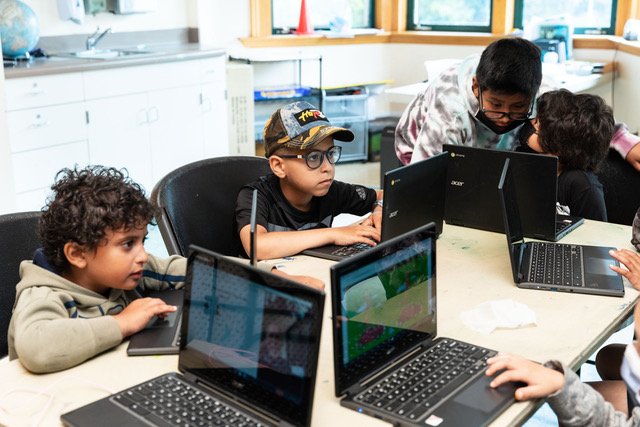CHILDREN’S HOMELESSNESS IN SAN FRANCISCO
Homelessness is complex and every day we witness it in San Francisco.
Thousands of children face this circumstance daily through no fault of their own.
It is a problem that together we can solve.
Research shows that education is a key way to lift homeless children up into a better way of life. Learn more below.
The best way to break the cycle of poverty is through education. Here are the facts.
54% of students in San Francisco are classified as low-income.
Source: SFUSD Innovate
75% of students from unhoused families can’t read at grade level.
Source: Urban Institute
Nearly 50% of SFUSD students are not reading-proficient.
Source: SFEdFund
Youth without a high school diploma/GED are 4.5 times more likely to experience homelessness later in life.
Source: Schoolhouse Connection
📚 Reading Is Key
Low-income neighborhoods have as few as 1 age-appropriate book per 300 children, while middle-income neighborhoods have about 13 books per child.
This statistic originates from studies like those conducted by Susan Neuman and Donna Celano (e.g., Access to Print in Low-Income and Middle-Income Communities: An Ecological Study of Four Neighborhoods.
Watch The Right To Read movie
In this documentary, NAACP activist Kareem Weaver sets out to reform the low reading scores in his home of Oakland, California. Featuring stories from Weaver's own life, a teacher and two American families, The Right to Read dives into the fight to provide our youngest generation with the most foundational skill for life-long success: the ability to read.
School Supplies matter when it comes to succeeding at school.
Here’s how a backpack and supplies benefit students in need:
1. Increased Attendance and Engagement
Providing school supplies can significantly increase school attendance among unhoused children. A study by the National Center for Homeless Education found that lack of supplies contributes to absenteeism. When children have the necessary materials, they are more likely to attend school and participate actively in class, which is critical for academic success .
2. Improved Academic Performance
Access to school supplies is linked to improved academic performance. The Kids In Need Foundation reported that students with necessary supplies are 2-3 times more likely to excel in academic achievements compared to those who lack them . Supplies such as notebooks, pencils, and calculators enable students to complete assignments and engage in learning activities effectively.
3. Enhanced Self-Esteem and Confidence
Having school supplies boosts self-esteem and confidence among students. According to research by the University of Toronto, children who are equipped with proper school supplies feel more prepared and confident, which translates to better classroom behavior and academic performance . This confidence helps them stay motivated and engaged in their studies.
4. Reduction in Behavioral Issues
Lack of school supplies can lead to frustration and behavioral problems. The American Psychological Association highlights that students without necessary materials often feel embarrassed and isolated, which can result in disruptive behavior and decreased participation in school activities . Providing supplies helps mitigate these issues, leading to a more positive learning environment.
5. Long-Term Economic Benefits
Investing in school supplies for unhoused children can yield long-term economic benefits. Education is a key factor in breaking the cycle of poverty. According to a study by the Urban Institute, children who complete their education are significantly more likely to secure stable employment and have higher lifetime earnings . Providing supplies supports their educational journey, which in turn improves their future economic prospects.
Sources:
Urban Institute: Ratcliffe, C. & McKernan, S. (2012). Childhood Poverty Persistence: Facts and Consequences. Retrieved from Urban Institute
University of Toronto: Klassen, R. M., & Lynch, S. L. (2007). Self-efficacy from the perspective of adolescents with learning disabilities and their specialist teachers. Journal of Learning Disabilities, 40(6), 494-507.
American Psychological Association: Vannest, K. J., & Harrison, J. R. (2011). Adolescents' behavioral risk factors and academic performance. Psychology in the Schools, 48(3), 267-279.
University of Chicago Consortium: Allensworth, E. M., & Easton, J. Q. (2007). What Matters for Staying On-Track and Graduating in Chicago Public High Schools. Retrieved from Consortium on Chicago School Research
Kids In Need Foundation: (2022). The Impact of School Supplies on Student Performance. Retrieved from Kids In Need Foundation
National Center for Homeless Education: (2019). Best Practices in Serving Homeless Students. Retrieved from NCHE
American Psychological Association: (2016). Behavioral Disorders: A Teacher’s Guide to Symptoms and Interventions. Retrieved from APA
National Association for the Education of Homeless Children and Youth (NAEHCY): (2021). Educational Rights of Children and Youth Experiencing Homelessness. Retrieved from NAEHCY
Institute for Children, Poverty, and Homelessness: (2020). Educational Attainment of Homeless Children: The Role of Support Services. Retrieved from ICPH
What Is Family Homelessness?
Homelessness does not just affect adults.
Homeless families are those without a home to live in.
Children live unhoused, in shelters, in cars, and on the streets through no fault of their own.
By supporting unhoused children with their education, UASF strives to help the entire family break free from the cycle of poverty.
“Adults and children in families make up about 30 percent of the homeless population.”
— National Alliance to End Homelessness
Our MissionUrban Angels SF gives dignity and hope to children facing homelessness and poverty in San Francisco through holistic, year-round educational support.
Our Partners & Donors




